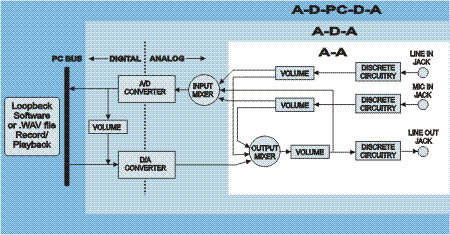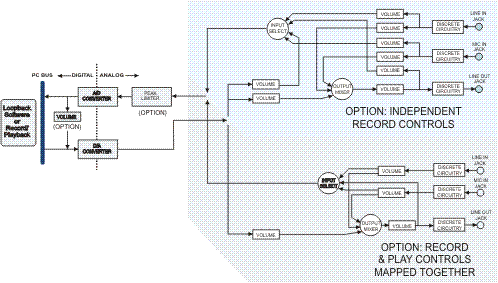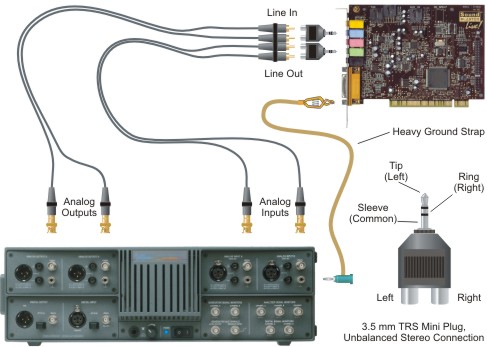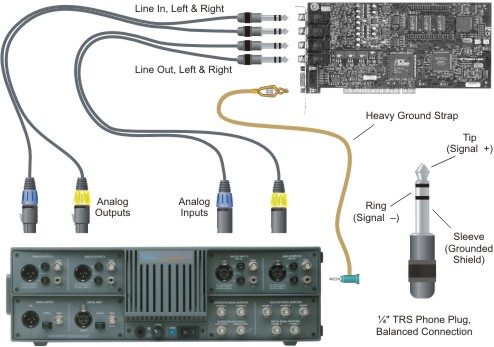
| Tech Tip # 2 PC Audio - A Sound Investment |
Sound cards and other audio devices for use as part of a PC system vary widely in their purposes, features and characteristics.
A Typical PC Sound Card
A
typical inexpensive PC sound card has, among other features, the capability
to record and play .wav file format 16-bit PCM stereo digital audio at
a 44.1 kHz sample rate. These cards also offer mono file capability, lower
sampling rates and 8-bit word length as options. Analog connections are
invariably unbalanced circuits with maximum levels of +6 dBV (2 V rms)
or often much less, provided on 3.5 mm mini phone jacks.
Designed for the mass market, such a PC sound card is often referred to
as a "consumer" sound card, as opposed to the "professional"
or "semi-pro" sound cards designed for specialized markets.
Recording
path
The recording signal path for a sound card includes a stereo input
stage with relatively high input impedances in the 10 kohms to 100 kohms
range, with a maximum input level sensitivity that can vary from as low
as -25 dBV to perhaps +6 dBV. The sound card driver software provides
a recording mixer to select and adjust analog inputs to the ADC (analog
to digital converter). Volume control changes from the mixer are accomplished
in the analog domain in discrete and often rather coarse steps. Gain,
commonly 30 dB, can be added to the Mic In channel by selecting the "Mic
Boost" option. The recording mixer typically will allow only one
input channel to be selected at a time. Cards so configured cannot mix
several input signals for recording. In some sound cards the analog signal
is applied to the input of the ADC linearly, allowing extreme signal excursions
and the possibility of exceeding the maximum input level of the ADC. In
other cases, the signal is routed through a peak limiter to prevent digital
clipping. While protecting the unwary user from severe distortion, this
can complicate measurement by making it difficult to determine the precise
input level necessary to produce 0 dB FS.
When the
presence of a peak limiter makes direct measurement of the onset of digital
clipping impossible, this full-scale level point can be inferred by making
a digital level measurement of a specific analog level. A low-level (-25
dBV) 997 Hz sine wave is applied to the input of the sound card and the
digital code created by the ADC in response to this analog signal is measured.
This digital data corresponds to an embedded audio level that can be expressed
in units of dB FS. With this baseline, the signal level required to produce
0 dB FS can be estimated and applied to the input of the sound card.
Nonlinearities in the sound card can throw off this estimate, so additional
tests are often required to better determine actual dBFS point. Several
THD+N measurements can be made at a series of levels near the estimated
dBFS point. This test increments the estimated input level up and down
in an attempt to locate the threshold of 1% distortion at the output of
the ADC. The largest applied input signal that produces just less than
1% distortion is then defined as 0 dBr. In the first case, measuring a
sound card with no limiter, 0 dBr = 0 dB FS. In measuring a card with
a limiter, 0 dBr = < 1 % THD+N, which will be close to but not exactly
0 dB FS, depending upon the behavior of the limiter.
Playback
path
The playback signal path for a sound card includes a stereo output
stage with relatively low output impedances in the 100 ohm range. Outputs
that are designed to drive headphones have even lower impedances. Analog
output levels for a 0 dB FS signal are typically between -1 dBV and +6
dBV; for outputs that are also designed to power speakers, the circuits
will have higher current capabilities and levels as high as +12 dBV. The
sound card driver software provides a playback mixer to adjust and mute
analog outputs from the DAC. Volume control changes from the mixer are
accomplished in the analog domain in discrete, coarse steps.
Sound
Card Driver Software
With
the exception of occasional configuration switches or jumpers, the functions
of PC sound cards are entirely controlled by driver software.
Although setting levels, selecting sources and recording and playing .wav
files through a PC sound card can be done in many different applications,
for test and measurement purposes it is often simplest to use the software
provided with Microsoft Windows: Windows Volume Control, Windows Sound
Recorder and Windows Media Player.
Audio
Connections
The consumer market sound card usually has three audio jacks on
the back panel: Line In, Mic In and Line Out; some also have Aux In, Speaker
Out or Surround jacks, and MIDI and game port connections. There are also
usually internal connections on Molex headers to the PC Compact Disc drive,
the PC speaker circuit and sometimes the PC telephone audio device (TAD).
PC Audio Tests uses only the Line Out connector and the Line In connectors.
On a typical sound card, these are invariably 3.5 mm stereo jacks, and
should be connected to System Two as shown:
A smaller percentage of sound cards are designed for specialized markets: specifically, the professional audio and broadcast industries, and semi-professional "project studio" environments. Although these cards offer more features, superior performance and better interfaces, in general the testing methods using PC Audio Tests are identical, with the interface connections being the primary difference. As always, there is great variance in features and implementation, but pro sound cards may offer:
- Full duplex operation (simultaneous file record and playback capability)
- Sampling
rate of 48 kHz
- Greater
resolution and signal to noise ratio, with digital word length of 20
or 24 bits.
- Pro-type
analog interfaces, with high-level, balanced connectionsd Cards
- Superior
analog circuitry, ADCs and DACs.
- Multitrack
capability (more than the standard left and right stereo tracks).
- Higher
sampling rates, such as 88.2 kHz or 96 kHz.
- Direct digital interfaces, such as S/PDIF, ADAT optical or AES3
Multitrack
capability
Pro audio cards may be able to record and play on more than just
the two standard (left and right) stereo channels, either by using two
or more physical cards (linked for synchronization) or by installing multiple
sound devices on a single physical sound card. Multitrack sound cards
come with proprietary software that allows simultaneous use of more than
two channels. Windows Sound Recorder, Windows Media Player and, for that
matter, System Two are all two-channel devices. But Microsoft Windows
does support use of more than one sound card, and using a multitrack card
in Windows you will find channels 3-4, 5-6, etc. as additional audio devices
by looking at the specific software that is provided by the manufacturer
of the multitrack sound card.




